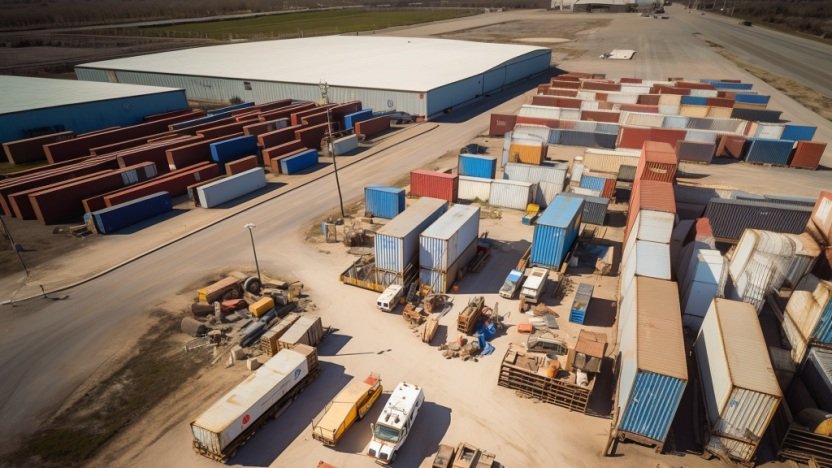Why High-Income Earners are Dumping Stocks for Industrial Warehouses
For decades, the conventional wisdom was simple: build wealth through the stock market. But today, more high-income earners are walking away from that playbook—and putting their capital into something far more tangible: industrial warehouses.
It’s not just about escaping volatility. It’s about gaining control, locking in consistent returns, and investing in the backbone of the modern economy.
While Wall Street rides waves of speculation and algorithmic trades, industrial real estate is quietly becoming the new gold standard for passive income and long-term appreciation. From Fortune 500 logistics hubs to last-mile distribution centers, these buildings are now magnets for capital from doctors, tech execs, and entrepreneurs looking to protect and grow their wealth.
In this post, we’ll explore why industrial warehouses are dominating investment conversations, what’s driving this shift among high earners, and how you can get in before the crowd catches on.
The Decline of Confidence in Stocks
Ask any financial advisor, and they’ll still recommend the same old 60/40 portfolio split—60% stocks, 40% bonds. But high-income earners are no longer buying in.
After a rollercoaster few years in the public markets, many investors are realizing that traditional stock investing isn’t giving them what they really want: predictability, control, and peace of mind.
Volatility Is the New Normal
Between inflation scares, interest rate hikes, tech layoffs, and global instability, the S&P 500 has become a battleground. One tweet or earnings miss can wipe out months of gains in a matter of hours.
Even blue-chip companies and well-known funds aren’t immune. And while long-term market averages may still look appealing on paper, the short-term stress, emotional toll, and unpredictability are pushing high earners to look for better options.
Lack of Control and Transparency
Public equities are managed from afar. As a stockholder, you have no real insight into operations, no say in strategy, and no ability to influence outcomes. You’re simply along for the ride—whether the market turns in your favor or not.
This is especially frustrating for entrepreneurs, physicians, and executives who are used to calling the shots in their businesses and seeing how their capital is being deployed in real time.
The Search for Stability
Wealthy investors aren’t necessarily fleeing stocks entirely—but they are rebalancing. They're pulling capital out of markets they can’t influence and into asset classes that provide more visibility, more stability, and more alignment with their long-term goals.
And right now, that path is leading straight to industrial real estate.
Why Industrial Real Estate is Stealing the Spotlight
Industrial real estate may not be making the same explosive headlines it did during the pandemic-driven logistics boom, but it’s still on the radar of savvy, high-income investors. The fundamentals have shifted—but not in a way that has diminished the asset class’s long-term value. If anything, it’s entering a more balanced, sustainable phase—precisely the kind of environment experienced investors look for.
Vacancies Are Rising—but Context Matters
As of Q2 2025, U.S. industrial vacancy rates have risen to between 6.6% and 7.5%, depending on the market and reporting source (CBRE, JLL). That’s a significant jump from the historic lows of 2021, when vacancy dipped below 4%.
But this increase is largely due to a flood of new construction—projects started during the 2021–2022 boom that are now hitting the market. Importantly, leasing volume remains strong, and most top-tier logistics corridors are still seeing healthy tenant demand. It’s not a collapse—it’s a recalibration.
Rent Growth Has Slowed—but Remains Positive
Gone are the days of double-digit year-over-year rent growth. In Q2 2025, national industrial asking rents are holding steady around $10.06 per square foot, with annualized growth of roughly 2.6%. That’s modest, but it’s still positive—and far more stable than what’s being seen in office or retail sectors.
In high-demand markets like Dallas or Atlanta, rent growth remains competitive, especially for last-mile or infill properties that offer speed-to-market advantages.
Demand Drivers Are Still in Place
Even with supply catching up, the long-term tailwinds for industrial remain intact:
E-commerce continues to drive demand for fulfillment and distribution centers, especially near major metros.
Reshoring and nearshoring trends have led manufacturers to secure more domestic warehouse space.
Supply chain diversification and “just-in-case” inventory strategies are still pushing demand for flexible, well-located industrial buildings.
Stability Over Speculation
Investors today aren’t betting on breakneck appreciation—they’re seeking cash-flowing assets with durable demand. Industrial real estate still checks those boxes, particularly when backed by experienced operators and conservative underwriting.
So while the wild run-up may be over, industrial real estate is proving what mature asset classes should: resilience, income, and long-term relevance. And for high-income investors looking to get off the Wall Street rollercoaster, that’s exactly what makes it appealing.
What makes industrial real estate so appealing to wealthy investors
Wealthy investors aren’t just chasing returns—they’re rethinking how they build and preserve capital in a more uncertain world. Stocks can surge and crash overnight. Luxury real estate is cyclical. And office buildings? Let’s not even go there.
What’s quietly gaining favor in their portfolios?
Industrial warehouses.
Not because they’re trendy—but because they’re reliable, tax-efficient, and operationally lean. The type of investment that does its job without drama.
Here’s what’s driving this strategic shift:
Industrial Is the New Core Holding, Not the Outlier
This isn’t a speculative play. Investors aren’t flipping warehouses. They’re holding them, leveraging long-term leases, and focusing on predictable, recurring income. Industrial space is now viewed as a foundational asset, not just an opportunistic one.
Think of it as the bond-replacement strategy for real estate investors—except with better upside and tax treatment.
The Numbers Actually Work
Unlike many asset classes where returns are inflated by speculation, industrial still offers real income supported by real demand. Cash-on-cash returns in the 6–8% range are still achievable, with internal rate of return (IRR) targets often in the low to mid-teens, especially on value-add or infill deals.
And for investors accustomed to 2–3% dividend yields from public REITs or high-volatility stock portfolios, this steady performance is a breath of fresh air.
Lean Overhead, Scalable Ownership
One of the biggest advantages of industrial property is how low-touch it can be. With many tenants handling their own improvements, repairs, and day-to-day operations, investors aren’t buried in CapEx requests or constant turnover.
This is why high-income earners—especially those running businesses or managing other ventures—gravitate toward it: they don’t have to babysit the investment.
Tax Strategy, Not Just Investment Strategy
High earners are always looking for ways to lower their taxable income. Industrial real estate offers some of the best tools in the game:
Accelerated cost segregation and bonus depreciation
Pass-through income with minimal self-employment tax
Opportunities for 1031 exchanges to defer capital gains indefinitely
These aren’t theoretical perks—they’re built into the structure of the investment and have a measurable impact on net returns.
This shift isn’t about chasing the next hot asset class. It’s about building a portfolio that works harder, moves slower, and throws off cash while you focus on the bigger picture.
How They’re Gaining Access (Without buying the building themselves)
Most high-income earners aren’t out touring industrial parks or negotiating loading dock leases. But they are investing in warehouses—and they’re doing it passively through private vehicles that give them exposure without the operational burden.
Here’s how they’re getting in:
Private Real Estate Funds
These funds pool investor capital to acquire and manage portfolios of industrial assets. They're often led by experienced sponsors who specialize in specific markets or strategies (like last-mile distribution, small-bay flex, or Class B infill product).
Pros: Professional management, diversified assets, built-in economies of scale.
Ideal for: Investors seeking exposure to industrial CRE without being hands-on.
Syndications
For those who want more direct ownership and visibility, syndications offer the chance to co-invest in a single deal or small portfolio. You invest as a limited partner (LP), while the general partner (GP) handles everything from acquisition to leasing to exit.
Typical minimums: $50K–$250K
Return structure: Often includes preferred returns (6–10%) plus profit splits.
Industrial-Focused REIT Alternatives
Some investors still prefer liquidity—but want more focus than broad REITs offer. That’s where non-traded REITs or sector-specific funds come in. These vehicles concentrate solely on industrial assets, often with long hold periods and modest redemption features.
Tradeoff: Less volatility than public REITs, but still not as tax-efficient as private deals.
Direct Ownership via Partnerships or Trusts
In some cases, high earners partner with operators they know personally to acquire and hold properties directly. This approach requires more capital and vetting but offers the most control and customization.
Why They Aren’t Doing It Alone
Even investors with eight-figure net worths rarely go solo in industrial. Why?
It’s operationally intensive without expertise
Market knowledge and sourcing relationships matter
The best deals are often off-market and invitation-only
By working with proven sponsors or fund managers, investors gain access to deals they’d never find on their own—and they get to stay passive while collecting checks.
Risks and Considerations
Industrial real estate isn’t risk-free. No investment is. But the difference with high-income investors is how they approach and manage risk, not how they avoid it.
Here are the top risks you should know—and how sophisticated investors protect themselves.
1. Rising Vacancy Rates
As of mid-2025, industrial vacancy rates have risen to 6–7.5% nationally. This shift is largely due to an oversupply from the post-pandemic construction boom.
How the wealthy mitigate it:
Focus on infill markets with land constraints and strong tenant demand.
Choose properties with essential tenants (logistics, manufacturing, cold storage).
Evaluate sponsor experience in lease-up strategies and tenant retention.
2. Market Saturation in Certain Regions
Some metros—particularly those that saw explosive growth in 2021–2022—are now overbuilt. New inventory can outpace absorption, pressuring rents and extending lease-up timelines.
How the wealthy mitigate it:
Invest in sponsors with local expertise, not national generalists.
Avoid “hot” markets that have already peaked—look for under-the-radar metros with long-term fundamentals.
Prioritize value-add opportunities where rents are still below market.
3. Tenant Credit Risk
Industrial tenants are typically stable—but not immune to economic shocks. A vacancy in a 100,000+ SF facility can impact cash flow fast.
How the wealthy mitigate it:
Underwrite tenant financials as thoroughly as the property.
Favor multi-tenant or small-bay properties to spread risk.
Structure leases with strong covenants, personal guarantees, and rent escalations.
4. Interest Rate Exposure
Rising interest rates have cooled transaction volume and made debt more expensive. Overleveraged deals can struggle to refinance or exit.
How the wealthy mitigate it:
Back deals with conservative leverage (usually 60–65% LTV or lower).
Lock in fixed-rate debt or include interest rate caps in underwriting.
Favor sponsors who stress-test deals at higher cap rates and interest levels.
5. Illiquidity
Private industrial investments typically involve multi-year hold periods with limited exit options.
How the wealthy mitigate it:
View illiquidity as a feature, not a bug—it supports long-term wealth building.
Diversify across multiple deals or funds to stagger capital access.
Maintain liquid reserves outside of real estate for flexibility.
Bottom line:
High-income earners don’t avoid risk—they structure around it. The key is working with sponsors who understand the current market cycle, underwrite conservatively, and prioritize cash flow over speculation.
Conclusion
The hype around industrial real estate may have peaked—but that’s exactly when disciplined, long-term investors double down.
High-income earners aren’t chasing short-term rent spikes or speculative ground-up development. They’re investing in stable, income-producing assets that solve real problems for real businesses—warehouses, distribution centers, and logistics facilities that support the modern economy.
In a world where public markets remain volatile, tax bills keep climbing, and many asset classes are saturated with speculation, industrial real estate continues to offer something rare: predictable cash flow, favorable tax treatment, and downside protection.
And thanks to private CRE funds, syndications, and specialized investment platforms, it’s never been more accessible to accredited investors looking to build wealth passively.
For those interested in delving deeper into commercial real estate investing, check out our course offerings. The courses provide in-depth insights, real-world case studies, and practical strategies to help you navigate the complexities of commercial real estate and achieve success in your ventures. Whether you're a seasoned investor or just starting in the world of commercial real estate, there's always more to learn. Equip yourself with the knowledge and tools you need to thrive in commercial real estate!










If you’ve been investing for a while, you know the grind.
You’ve closed deals, managed contractors, worked through leases, and seen both wins and setbacks. Maybe you’ve owned single-family rentals, a few duplexes, or even some small commercial buildings. You understand the fundamentals: how to run numbers, navigate debt, and keep properties occupied.
But here’s a question that hits at a different level: are your investments giving you leverage or just more responsibility?
As your portfolio grows, so does the complexity. More tenants often mean more phone calls. Bigger buildings bring additional systems, staff, and liability. And while your equity might be growing on paper, your time can get stretched thin across too many directions.
That’s why more experienced investors are quietly shifting toward asset classes that offer something rare in commercial real estate: simplicity that still delivers strong returns.
Two of the most overlooked categories in this space are flex industrial and industrial outdoor storage (IOS).
They’re not flashy. You won’t find them in luxury investor decks or high-end brochures. But these properties produce solid returns, attract long-term tenants, and are surprisingly light on operational headaches. Best of all, they give seasoned investors a way to keep growing without being consumed by the demands of their portfolio.
In this post, we’ll walk through:
What makes flex and IOS so attractive
The numbers behind why they work
How they fit into a growing portfolio
And why they might be the most strategic asset class you haven’t explored yet
This is not about going bigger for the sake of scale. It’s about going smarter.
Because the goal is not more units. It’s more freedom.